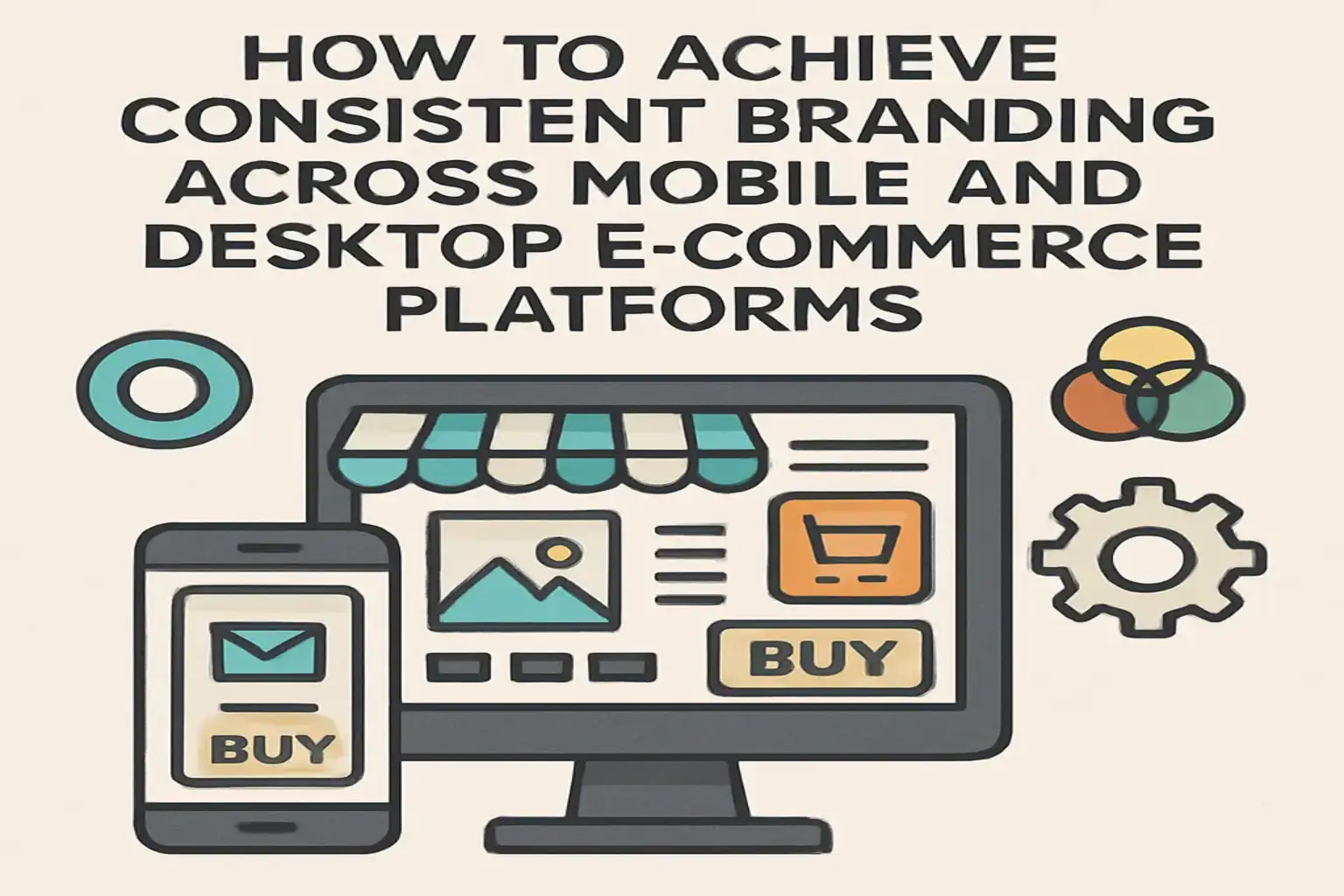
In today’s digital age, e-commerce businesses face the challenge of maintaining consistent branding across platforms. Mobile and desktop experiences must align to build trust and recognition.
A seamless brand presence enhances customer loyalty and sets businesses apart from competitors.
Achieving this consistency requires a strategic approach, integrating design, marketing, and technology.
Omnichannel retail strategies and marketing automation tools play crucial roles in this process.
This guide will explore actionable steps to ensure your brand remains consistent across all e-commerce platforms.
The Importance of Consistent Branding
Consistent branding is essential for establishing a strong identity in the e-commerce marketplace. It ensures your brand is easily recognizable across different platforms and devices. A unified brand appearance bolsters customer confidence and fosters trust.
When customers encounter a seamless brand experience, it leads to increased loyalty and retention. Consistent branding also helps reduce customer confusion by providing clear and uniform messaging.
Key benefits of consistent branding include:
- Increased customer trust
- Enhanced brand loyalty
- Competitive differentiation
A strong, consistent brand not only attracts new customers but also retains existing ones. It reinforces the value your business offers.
Brand Recognition and Loyalty
Brand recognition is pivotal in a crowded e-commerce space. Consistent branding enhances visibility, making it easier for customers to recall your business.
A coherent brand presence across platforms builds loyalty over time. Customers appreciate familiarity and reliability.
Steps to enhance recognition and loyalty:
- Use a unified color palette
- Implement consistent typography
- Maintain tone and messaging
These strategies reinforce your brand identity and resonate with your audience consistently.
Cross-Platform User Trust
Trust is critical for successful e-commerce operations. Consistent branding across mobile and desktop platforms strengthens user confidence.
When customers see the same brand elements on different devices, it reduces skepticism. It assures them of continuity and quality in your offerings.
A unified appearance translates into trust and higher engagement, boosting your overall brand credibility.
Understanding User Interface Design Across Platforms
User interface design plays a vital role in maintaining brand consistency across different platforms. Each platform, be it mobile or desktop, presents unique challenges and opportunities. However, the core brand identity should remain recognizable.
The best approach is to tailor the user interface to the medium while adhering to the brand’s visual elements. This involves careful planning and a deep understanding of user behavior on each platform.
Important aspects to consider include:
- Consistent navigation structures
- Unified visual branding
- Adapted content layouts for varying screen sizes
Effective UI design ensures users experience a seamless transition between platforms, reinforcing brand strength and reliability.
Key Principles for Effective UI Design
Effective UI design hinges on simplicity and clarity. Users should navigate your interface intuitively, without confusion or delay. Consistency in design elements across platforms is crucial.
Design principles for effective UI include:
- Prioritizing accessibility
- Maintaining consistent design language
- Implementing responsive design techniques
These principles ensure that the user experience remains cohesive and aligned with your branding goals, fostering a positive interaction with your brand.
Adapting UI for Mobile vs. Desktop
Adapting UI design for mobile versus desktop involves understanding different user expectations. Mobile users prioritize speed and simplicity, while desktop users may seek more detailed content.
UI adaptation techniques include:
- Simplifying navigation for mobile users
- Optimizing images and media for quick loading
- Ensuring touch-friendly design elements
By tailoring UI design to the strengths and limitations of each platform, you preserve brand coherence and enhance user satisfaction across all devices.
Implementing an Omnichannel Marketing Strategy
An omnichannel marketing strategy seamlessly connects your brand across multiple platforms. It ensures a unified customer experience regardless of the device or channel. This approach enhances brand consistency and maximizes reach.
To implement this strategy, focus on integrating customer data. This provides a holistic view of interactions across all touchpoints. Align content and messaging to create a seamless journey.
Key considerations for an effective strategy include:
- Consistent messaging across channels
- Integration of customer data
- Responsive and adaptive design
Investing in omnichannel marketing transforms the way customers interact with your brand. It ensures they receive the same quality experience, whether on mobile, desktop, or in-store.
Defining Omnichannel Marketing
Omnichannel marketing connects all customer interactions across platforms into a single, cohesive experience. This strategy goes beyond simply being present on multiple channels.
Essential characteristics of omnichannel marketing are:
- Integrated data systems for a seamless experience
- Consistent messaging and branding
- Cross-platform adaptability
By connecting different channels, brands enable customers to transition seamlessly, strengthening brand loyalty and engagement.
Benefits of an Omnichannel Approach
An omnichannel approach offers numerous advantages. It enhances the customer experience and boosts brand loyalty. By maintaining consistency, customers feel understood and engaged.
Advantages of an omnichannel approach include:
- Greater customer engagement and retention
- Improved data collection and personalization
- Consistent brand experience
This approach is crucial for reinforcing your brand’s identity and staying competitive in a dynamic market. It ensures your brand remains relevant and connected to your customers’ needs.
Utilizing Marketing Automation Tools
Marketing automation tools play a critical role in maintaining consistent branding. They help synchronize your brand’s message across multiple channels. Automating repetitive tasks improves efficiency, allowing your team to focus on creative strategies.
These tools can organize campaigns and manage content delivery effectively. They simplify integration across platforms, ensuring messages align with your brand identity. Automation enables real-time updates, keeping your brand message current.
Key features include:
- Content scheduling and management
- Data analytics for tracking performance
- Personalized customer interactions
Implementing these tools can enhance your marketing efforts, drive engagement, and ensure a unified customer experience across various channels.
Streamlining Brand Messaging
Streamlining brand messaging is key to maintaining a unified presence. Automation tools facilitate this process by centralizing content management. This ensures all communications reflect your brand’s voice and tone consistently.
By leveraging these tools, you can maintain a coherent message, ensuring customers recognize your brand at every interaction. This contributes to building trust and reinforcing brand identity.
Ensuring Consistency Across Campaigns
Consistency in branding campaigns is essential for success. Automation tools can ensure that your brand message remains stable. They coordinate efforts across different channels efficiently.
Key benefits include:
- Uniform branding across campaigns
- Streamlined communication processes
- Synchronized multi-channel efforts
These tools support brand consistency, allowing for cohesive and coordinated marketing activities. Maintaining a clear and constant brand message helps establish credibility and customer loyalty.
Enhancing Mobile User Experience
Enhancing the mobile user experience is vital as more consumers shop on mobile devices. A responsive design ensures your site adapts to various screen sizes effectively. Prioritize mobile-first design to cater to users’ needs without compromising on desktop platforms.
By improving mobile UX, you provide a smoother, more engaging experience. This approach can boost customer satisfaction and drive conversions. Key elements to consider include:
- Fast loading times
- Simple and intuitive navigation
- Mobile-friendly content layout
Regularly assessing mobile performance can help identify areas for improvement. Gathering user feedback provides valuable insights to refine the experience continually.
Optimizing Design for Mobile
Optimizing your design for mobile enhances usability and engagement. Focus on creating a clean, clear interface that prioritizes essential features. Testing design elements helps determine their effectiveness in a mobile context.
Ensure your mobile design includes:
- Easy-to-tap buttons
- Readable font sizes
- Streamlined content presentation
Simplifying design reduces user frustration, improving both engagement and retention. A seamless and intuitive design can significantly elevate the mobile user experience, fostering brand loyalty.
Seamless Navigation and Interaction
Creating seamless navigation and interaction is crucial for mobile platforms. Users should easily find what they need without excessive scrolling. A well-organized layout enhances usability and satisfaction.
Responsive menus and clear pathways improve user interaction. Simplified navigation encourages users to explore and engage with your content. A frictionless experience strengthens brand perception and loyalty, setting your e-commerce platform apart.
Case Studies of Successful Brands
Exploring case studies of successful brands can provide valuable insights into consistent branding. These examples illustrate effective strategies in maintaining brand integrity across platforms. They highlight how a unified brand voice impacts customer perception and engagement.
One noteworthy brand is Apple. Apple exemplifies sleek design and uniformity in its branding. Their consistent use of minimalism and innovation sets them apart. Another is Nike, which implements strong, recognizable brand elements both online and offline. Their Just Do It campaign reflects uniform messaging and powerful visual storytelling. Finally, consider Amazon. Amazon exemplifies seamless user experience and functional UI design, creating trust and loyalty among users.
Through these examples, the power of consistent branding across e-commerce platforms becomes clear. Each brand illustrates unique ways to maintain integrity while engaging diverse audiences.
Analysis of Brand Consistency in Action
Analyzing brand consistency in successful companies reveals core tactics for uniform branding. A primary feature is a strong visual identity, maintained across all channels. Consistent brand messaging ensures customers have a cohesive experience.
Consider how IKEA presents a unified brand image:
- Consistent typography and color schemes
- Unified product presentations
- Cohesive marketing campaigns
This consistent approach reinforces their brand and helps in building user trust and loyalty.
Lessons Learned from Top E-commerce Platforms
From top e-commerce platforms, we learn critical lessons in maintaining brand consistency. Ensuring that brand elements align with the overall mission is key.
Further, adapting design while preserving the core identity keeps brands relevant. Efficient communication across channels offers seamless customer interactions. Ultimately, consistency fosters trust and aids in long-term customer relationships.
Conclusion
Achieving consistent branding across mobile and desktop platforms is essential for e-commerce success. It fosters trust, enhances user experience, and strengthens customer loyalty.
By employing an effective omnichannel strategy and utilizing automation tools, brands can maintain their identity. Consistency not only differentiates businesses but also drives growth and customer engagement across various platforms.





